时间状语从句讲解和练习(答案)
- 格式:docx
- 大小:20.74 KB
- 文档页数:6
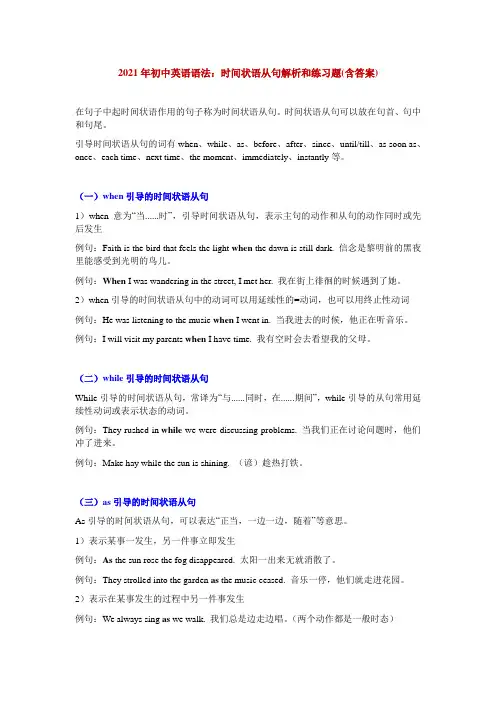
2021年初中英语语法:时间状语从句解析和练习题(含答案)在句子中起时间状语作用的句子称为时间状语从句。
时间状语从句可以放在句首、句中和句尾。
引导时间状语从句的词有when、while、as、before、after、since、until/till、as soon as、once、each time、next time、the moment、immediately、instantly等。
(一)when引导的时间状语从句1)when意为“当......时”,引导时间状语从句,表示主句的动作和从句的动作同时或先后发生例句:Faith is the bird that feels the light when the dawn is still dark. 信念是黎明前的黑夜里能感受到光明的鸟儿。
例句:When I was wandering in the street, I met her. 我在街上徘徊的时候遇到了她。
2)when引导的时间状语从句中的动词可以用延续性的=动词,也可以用终止性动词例句:He was listening to the music when I went in. 当我进去的时候,他正在听音乐。
例句:I will visit my parents when I have time. 我有空时会去看望我的父母。
(二)while引导的时间状语从句While引导的时间状语从句,常译为“与......同时,在......期间”,while引导的从句常用延续性动词或表示状态的动词。
例句:They rushed in while we were discussing problems. 当我们正在讨论问题时,他们冲了进来。
例句:Make hay while the sun is shining. (谚)趁热打铁。
(三)as引导的时间状语从句As引导的时间状语从句,可以表达“正当,一边一边,随着”等意思。
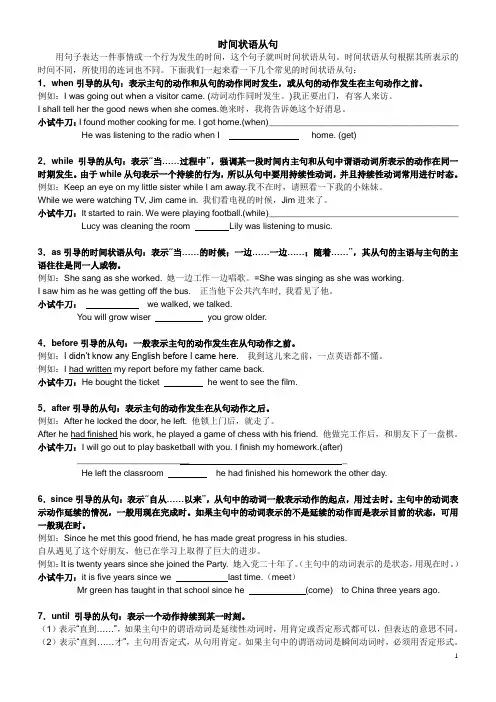
时间状语从句用句子表达一件事情或一个行为发生的时间,这个句子就叫时间状语从句。
时间状语从句根据其所表示的时间不同,所使用的连词也不同。
下面我们一起来看一下几个常见的时间状语从句:1.when引导的从句:表示主句的动作和从句的动作同时发生,或从句的动作发生在主句动作之前。
例如:I was going out when a visitor came. (动词动作同时发生。
)我正要出门,有客人来访。
I shall tell her the good news when she comes.她来时,我将告诉她这个好消息。
小试牛刀:I found mother cooking for me. I got home.(when)_______________________________________ He was listening to the radio when I home. (get)2.while 引导的从句:表示“当……过程中”,强调某一段时间内主句和从句中谓语动词所表示的动作在同一时期发生。
由于while从句表示一个持续的行为,所以从句中要用持续性动词,并且持续性动词常用进行时态。
例如:Keep an eye on my little sister while I am away.我不在时,请照看一下我的小妹妹。
While we were watching TV, Jim came in. 我们看电视的时候,Jim进来了。
小试牛刀:It started to rain. We were playing football.(while)_______________________________________ Lucy was cleaning the room Lily was listening to music.3.as引导的时间状语从句:表示“当……的时候;一边……一边……;随着……”,其从句的主语与主句的主语往往是同一人或物。
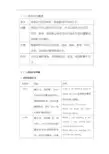
(一)状语从句概述定义状语从句用作状语,是起副词作用的句子。
位置状语从句可以放在主句之前,也可以放在主句之后,时间、条件、原因和让步状语从句放在句首时需要用逗号和主句隔开。
分类根据其作用可以分为时间、地点、原因、条件、目的、让步、方式和比较等状语从句。
作用它可以修饰谓语、非谓语动词、定语、状语和整个句子。
(二)状语从句详解1. 时间状语从句引导词用法示例when 意为“当…的时候”。
When引导从句的谓语动词可以是延续性动词,也可以是瞬间动词。
并且when有时表示“就在那时”A liar is not believed when he speaks the truth.说谎者讲真话时也没有人相信。
When he arrives, I’ll call you. When you laugh and smile, your body relaxes.while 意为“在…的时候,在…的同时”。
While引导从句的谓语动词必须是延续性的,发生时间较长,并强While I was standing at the window, I saw several boys running along the street.While John was watching TV, his wife was cooking.调主句和从句的动作同时发生(或者相对应)。
While 有时还可以表示对比。
as 意为“一边…一边…”。
As引导的动作是延续性的,发生时间较短,一般用于主句和从句动作同时发生;as也可以强调一前一后。
The writer was angry as he was travelling on a train to London because someone had invaded his “space”.He smiled as he stood up.after 意为“在…之后”。
表示主句动作发生在从句动作之后。
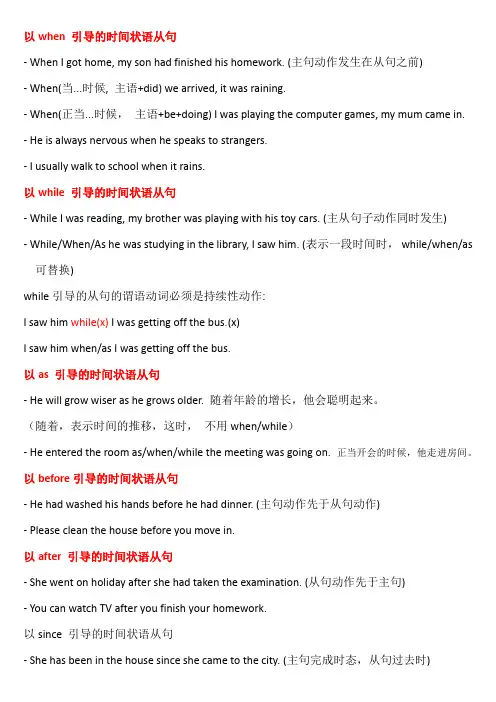
以when 引导的时间状语从句- When I got home, my son had finished his homework. (主句动作发生在从句之前)- When(当...时候, 主语+did) we arrived, it was raining.- When(正当...时候,主语+be+doing) I was playing the computer games, my mum came in. - He is always nervous when he speaks to strangers.- I usually walk to school when it rains.以while 引导的时间状语从句- While I was reading, my brother was playing with his toy cars. (主从句子动作同时发生)- While/When/As he was studying in the library, I saw him. (表示一段时间时,while/when/as 可替换)while引导的从句的谓语动词必须是持续性动作:I saw him while(x) I was getting off the bus.(x)I saw him when/as I was getting off the bus.以as 引导的时间状语从句- He will grow wiser as he grows older. 随着年龄的增长,他会聪明起来。
(随着,表示时间的推移,这时,不用when/while)- He entered the room as/when/while the meeting was going on. 正当开会的时候,他走进房间。
以before引导的时间状语从句- He had washed his hands before he had dinner. (主句动作先于从句动作)- Please clean the house before you move in.以after 引导的时间状语从句- She went on holiday after she had taken the examination. (从句动作先于主句)- You can watch TV after you finish your homework.以since 引导的时间状语从句- She has been in the house since she came to the city. (主句完成时态,从句过去时)- I have taught them English since last year.以as soon as引导的时间状语从句- I will write to you as soon as I get to America. 我一到美国就会给你写信。
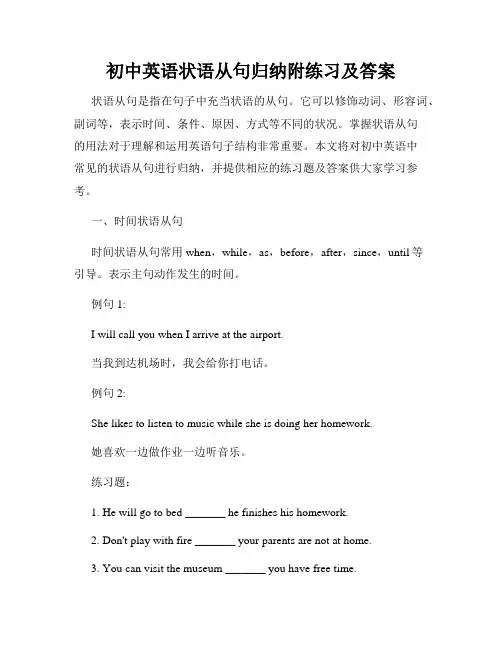
初中英语状语从句归纳附练习及答案状语从句是指在句子中充当状语的从句。
它可以修饰动词、形容词、副词等,表示时间、条件、原因、方式等不同的状况。
掌握状语从句的用法对于理解和运用英语句子结构非常重要。
本文将对初中英语中常见的状语从句进行归纳,并提供相应的练习题及答案供大家学习参考。
一、时间状语从句时间状语从句常用when,while,as,before,after,since,until等引导。
表示主句动作发生的时间。
例句1:I will call you when I arrive at the airport.当我到达机场时,我会给你打电话。
例句2:She likes to listen to music while she is doing her homework.她喜欢一边做作业一边听音乐。
练习题:1. He will go to bed _______ he finishes his homework.2. Don't play with fire _______ your parents are not at home.3. You can visit the museum _______ you have free time.1. after2. while3. whenever二、条件状语从句条件状语从句通常使用if或unless引导。
表示条件或假设的情况。
例句1:If it rains tomorrow, we will stay at home.如果明天下雨,我们就待在家里。
例句2:You will pass the exam unless you work hard.除非你努力学习,否则你将无法通过考试。
练习题:1. I will buy a new car _______ I save enough money.2. _______ you study hard, you will fail the exam.3. She won't go shopping with you _______ it stops raining.答案:1. if3. until三、原因状语从句原因状语从句常用because,since,as等引导。
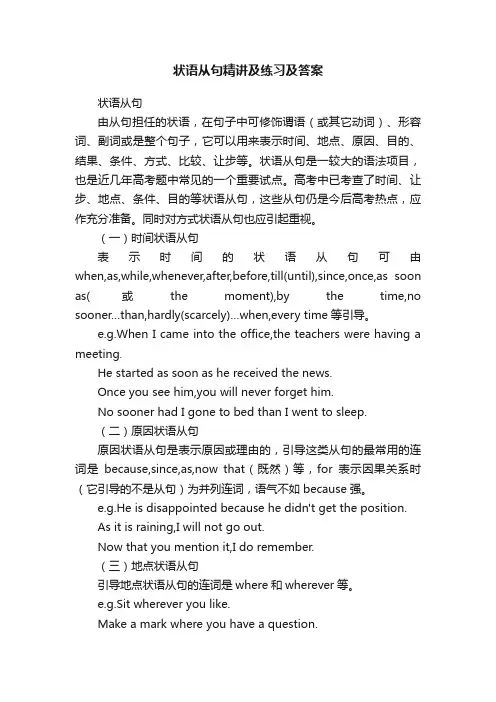
状语从句精讲及练习及答案状语从句由从句担任的状语,在句子中可修饰谓语(或其它动词)、形容词、副词或是整个句子,它可以用来表示时间、地点、原因、目的、结果、条件、方式、比较、让步等。
状语从句是一较大的语法项目,也是近几年高考题中常见的一个重要试点。
高考中已考查了时间、让步、地点、条件、目的等状语从句,这些从句仍是今后高考热点,应作充分准备。
同时对方式状语从句也应引起重视。
(一)时间状语从句表示时间的状语从句可由when,as,while,whenever,after,before,till(until),since,once,as soon as(或the moment),by the time,no sooner…than,hardly(scarcely)…when,every time等引导。
e.g.When I came into the office,the teachers were having a meeting.He started as soon as he received the news.Once you see him,you will never forget him.No sooner had I gone to bed than I went to sleep.(二)原因状语从句原因状语从句是表示原因或理由的,引导这类从句的最常用的连词是because,since,as,now that(既然)等,for表示因果关系时(它引导的不是从句)为并列连词,语气不如because强。
e.g.He is disappointed because he didn't get the position.As it is raining,I will not go out.Now that you mention it,I do remember.(三)地点状语从句引导地点状语从句的连词是where和wherever等。
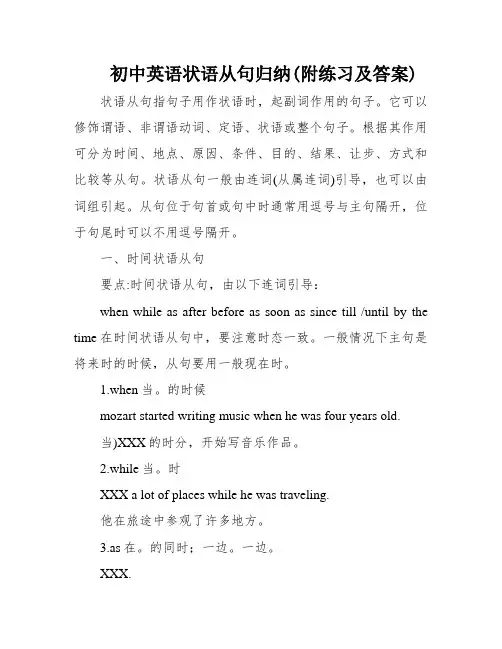
初中英语状语从句归纳(附练习及答案)状语从句指句子用作状语时,起副词作用的句子。
它可以修饰谓语、非谓语动词、定语、状语或整个句子。
根据其作用可分为时间、地点、原因、条件、目的、结果、让步、方式和比较等从句。
状语从句一般由连词(从属连词)引导,也可以由词组引起。
从句位于句首或句中时通常用逗号与主句隔开,位于句尾时可以不用逗号隔开。
一、时间状语从句要点:时间状语从句,由以下连词引导:when while as after before as soon as since till /until by the time在时间状语从句中,要注意时态一致。
一般情况下主句是将来时的时候,从句要用一般现在时。
1.when当。
的时候mozart started writing music when he was four years old.当)XXX的时分,开始写音乐作品。
2.while当。
时XXX a lot of places while he was traveling.他在旅途中参观了许多地方。
3.as在。
的同时;一边。
一边。
XXX.他一边站起来一边笑着。
4.after在。
之后he left the classroom after he had finished his homework the other day.前几天做完作业之后回的家。
5.before在。
之前XXX.XXX先生来这之前已经在一家银行里工作一年了。
6.XXX。
就。
we began to work as soon as we got there.我们一到那就开始工作。
i will write to you as soon as i get home.我一到家就给你写信。
7.since自。
以来到现在透露表现自曩昔的一个出发点工夫到目前(语言工夫)为止的一段延续工夫。
主句普通用目前完成时,从句用普通曩昔时。
mr green has taught in that school since he came to china three years ago.自XXX先生来中国以来,他就在这所学校教书。
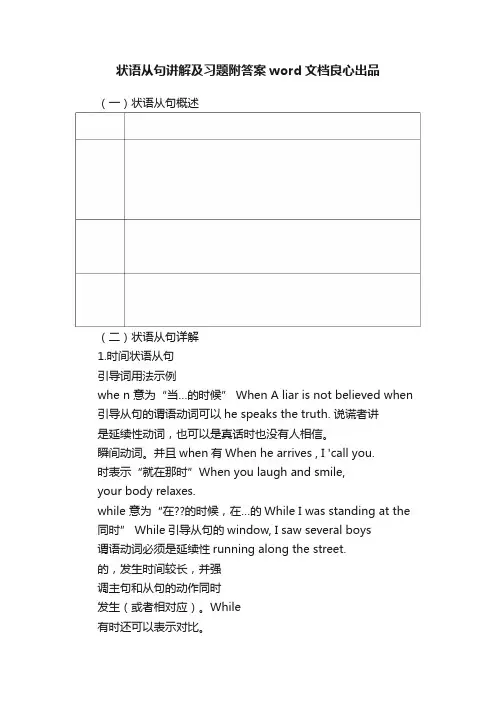
状语从句讲解及习题附答案word文档良心出品(一)状语从句概述(二)状语从句详解1.时间状语从句引导词用法示例whe n 意为“当…的时候” When A liar is not believed when 引导从句的谓语动词可以he speaks the truth. 说谎者讲是延续性动词,也可以是真话时也没有人相信。
瞬间动词。
并且when有When he arrives , I 'call you.时表示“就在那时”When you laugh and smile,your body relaxes.while 意为“在??的时候,在…的While I was standing at the 同时” While引导从句的window, I saw several boys谓语动词必须是延续性running along the street.的,发生时间较长,并强调主句和从句的动作同时发生(或者相对应)。
While有时还可以表示对比。
as 意为“一边…一边…” As引导的动作是延续性的,发生时间较短,一般用于主句和从句动作同时发生;as也可以强调一前一后。
after 意为“在??之后”表示主句动作发生在从句动作之后。
主句与从句的动作时间关系与before引导的从句相反。
before 意为“在??之前”引导的从句不用否定形式的谓语,并且当before引导的从句位于主句之后,有时译成While John was watchingTV, his wife was cook ing.The writer was angry as hewas travelling on a train to London because someonehad inv aded his sp ace ”.He smiled as he stood up.With many hungry visitors waiting, don' stay too longat your table after you havefini shed.If an early exit is n ecessary, you can leave after a sceneis over.You can ' watch TV beforeyou finish your homework. Before it ended, the theatre was almost empty.“就才”当主句用将来时,My father had left for Ca nada意为“自从,从??以来”引since I have been studying hardI will call you as soon as Iarrive.2. 地点状语从句引导词用法示例where意为“哪里。
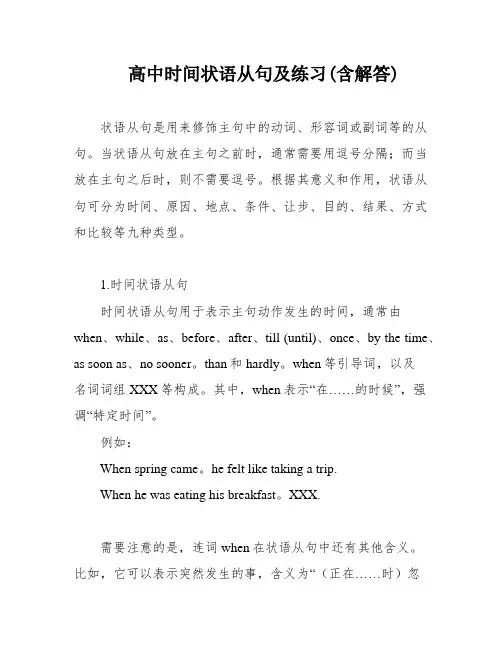
高中时间状语从句及练习(含解答)状语从句是用来修饰主句中的动词、形容词或副词等的从句。
当状语从句放在主句之前时,通常需要用逗号分隔;而当放在主句之后时,则不需要逗号。
根据其意义和作用,状语从句可分为时间、原因、地点、条件、让步、目的、结果、方式和比较等九种类型。
1.时间状语从句时间状语从句用于表示主句动作发生的时间,通常由when、while、as、before、after、till (until)、once、by the time、as soon as、no sooner。
than和hardly。
when等引导词,以及名词词组XXX等构成。
其中,when表示“在……的时候”,强调“特定时间”。
例如:When spring came。
he felt like taking a trip.When he was eating his breakfast。
XXX.需要注意的是,连词when在状语从句中还有其他含义。
比如,它可以表示突然发生的事,含义为“(正在……时)忽然”;可以表示过早发生某事,意为“(还没……)就”;还可以表示“在……的情况下”,通常译为“虽然”、“既然”、“如果”等。
举个例子:I was just coming along to see you when I ran into Wilson.I hadn’t been reading for half an hour when I heard steps outside.She refuses help when (although) she has many friends.Why do you walk when (since) you have a car?How can I make them understand if they refuse to listen to me。
It's frustrating when you XXX。
![高中时间状语从句和练习[含答案解析]](https://uimg.taocdn.com/ebd3a8f8d05abe23482fb4daa58da0116c171f22.webp)
高中时间状语从句和练习[含答案解析]状语从句状语从句在句中作状语,修饰主句中的动词、形容词或副词等。
状语从句放在主句之前时,常用逗号分开;放在主句之后,一般不用逗号。
状语从句按其意义和作用可分为时间、原因、地点、条件、让步、目的、结果、方式、比较等9种。
1.时间状语从句时间状语从句表示主句动作发生的时间,主要由when,while,as ; before, after; till (until); once, by the time, as soon as, no sooner ... than和hardly ... when及名词词组the moment等引导。
1) when“在……的时候”; while “在……期间”; as “正当……的时候”when意为“在……的时候”,强调“特定时间”。
When spring came, he felt like a trip.When he was eating his breakfast, he heard the doorbell ring.说明:连词when在状语从句中还有如下几种含义:①表示突然发生的事,含义为“(正在……时)忽然”。
I was just coming along to see you when I ran into Wilson.I had been working a couple of months when I had a letter from Jane.②表示过早发生某事,意为“(还没……)就”。
此含义有时可用before代替。
I hadn’t been rea ding for half an hour when I heard steps outside.我刚读了不到半个小时就听到外面有脚步声。
I had been there little more than a week when I set to work in earnest.③表示“在……的情况下”,常可译为“虽然”,“既然”,“如果”。
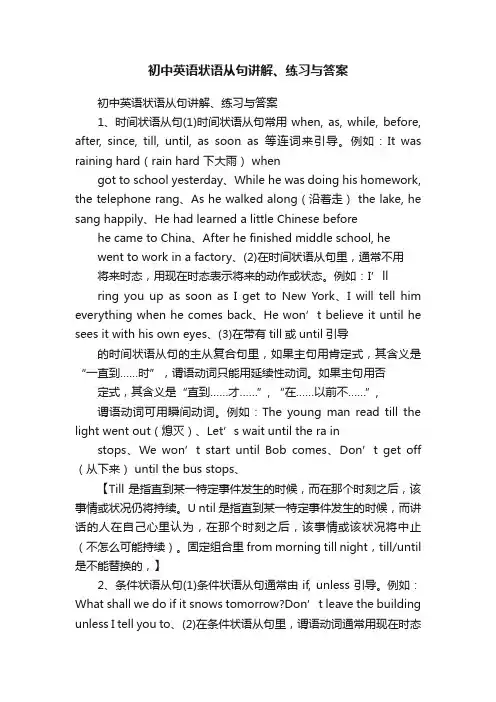
初中英语状语从句讲解、练习与答案初中英语状语从句讲解、练习与答案1、时间状语从句(1)时间状语从句常用when, as, while, before, after, since, till, until, as soon as等连词来引导。
例如:It was raining hard(rain hard 下大雨) whengot to school yesterday、While he was doing his homework, the telephone rang、As he walked along(沿着走) the lake, he sang happily、He had learned a little Chinese before he came to China、After he finished middle school, hewent to work in a factory、(2)在时间状语从句里,通常不用将来时态,用现在时态表示将来的动作或状态。
例如:I’llring you up as soon as I get to New York、I will tell him everything when he comes back、He won’t believe it until he sees it with his own eyes、(3)在带有till或until引导的时间状语从句的主从复合句里,如果主句用肯定式,其含义是“一直到……时”,谓语动词只能用延续性动词。
如果主句用否定式,其含义是“直到……才……”, “在……以前不……”,谓语动词可用瞬间动词。
例如:The young man read till the light went out(熄灭)、Let’s wait until the ra instops、We won’t start until Bob comes、Don’t get off (从下来) until the bus stops、【Till是指直到某一特定事件发生的时候,而在那个时刻之后,该事情或状况仍将持续。
状语从句主要用来修饰主句或主句的谓语。
一般可分为九大类,分别表示时间、地点、原因、目的、结果、条件、让步、比较和方式。
尽管种类较多,但由于状语从句与汉语结构和用法相似,所以理解和掌握它并不难。
状语从句的关键是要掌握引导不同状语从句的常用连接词和特殊的连接词即考点。
现分别列举如下:1、时间状语从句常用引导词:when, as, while, as soon as, while, before, after, since , till, until特殊引导词:the minute, the moment, the second, every time, the day,the instant, immediately , directly, no sooner … than, hardly …when, scarcely … whenI didn't realize how special my mother was until I became an adult.While John was watching TV, his wife was cooking.The children ran away from the orchard(果园) the moment they saw the guard.No sooner had I arrived home than it began to rain.Every time I listen to your advice, I get into trouble.2、地点状语从句常用引导词:where特殊引导词:wherever, anywhere, everywhereGenerally, air will be heavily polluted where there are factories.Wherever you go, you should work hard.3、原因状语从句常用引导词:because, since, as, for特殊引导词:seeing that, now that, in that, considering that, given that, considering that, as much as, so much asMy friends dislike me because I'm handsome and successful.Now that everybody has come, let's begin our conference.The higher income tax is harmful in that it may discourage people from trying to earn more.Considering that he is no more than 12 years old, his height of 1.80 m is quite remarkable.4、目的状语从句常用引导词:so that, in order that特殊引导词:lest, in case, for fear that,in the hope that, for the purpose that, to the end thatThe boss asked the secretary to hurry up with the letters so that he could sign them.The teacher raised his voice on purpose that the students in the back could hear more clearly.5、结果状语从句常用引导词:so that, so… that, such … that,特殊引导词:such that, to the degree that, to the extent that, to such a degree that, He got up so early that he caught the first bus.It's such a good chance that we must not miss it.To such an degree was he excited that he couldn't sleep last night.6、条件状语从句常用引导词:if, unless,特殊引导词:as/so long as, only if, providing/provided that, suppose that, in case that, on condition thatWe'll start our project if the president agrees.You will certainly succeed so long as you keep on trying.Provided that there is no opposition, we shall hold the meeting here.7、让步状语从句常用引导词:though, although, even if, even though特殊引导词: as(用在让步状语从句中必须要倒装),while ( 一般用在句首),no matter …, in spite of the fact that, while, whatever, whoever, wherever, whenever, however, whicheverMuch as I respect him, I can't agree to his proposal.尽管我很尊敬他, 我却不同意他的建议。
四年级英语时间状语从句练习题20题含答案解析1.I was reading a book when my mother came in.A.whenB.whileC.asD.then答案解析:A。
本题考查when 的用法。
when 表示“当……的时候”,引导时间状语从句。
while 通常表示两个动作同时进行,as 也表示两个动作同时进行,但本题中妈妈进来是一个短暂的动作,用when 更合适。
then 不是时间状语从句的引导词。
2.I was doing my homework while my brother was playing games.A.whenB.whileC.asD.and答案解析:B。
while 强调两个动作同时进行。
when 虽然也可引导时间状语从句,但在这里不如while 贴切。
as 也表示同时,但没有while 常用。
and 是并列连词,不是时间状语从句引导词。
3.My father was watching TV as I was having dinner.A.whenB.whileC.asD.but答案解析:C。
as 表示两个动作同时进行,符合本题语境。
when 和while 虽然也可引导时间状语从句,但这里as 更能体现出“一边……一边……”的同时性。
but 是转折连词,不是时间状语从句引导词。
4.I saw a beautiful bird when I was walking in the park.A.whenB.whileC.asD.for答案解析:A。
when 引导的时间状语从句,表示“当……的时候”,符合本题语境。
while 通常用于两个动作同时进行,as 也表示同时,但这里看到鸟是一个瞬间动作,用when 更合适。
for 不是时间状语从句引导词。
5.I was listening to music while my sister was dancing.A.whenB.whileC.asD.or答案解析:B。
状语从句1.在主从复合句中修饰主句中的动词,形容词,副词等的从句叫状语从句。
可分为,时间状语从句,地点状语从句,原因,目的,结果,条件,让步,比较和方式状语从句。
2.时间状语从句起时间状语作用的句子;可放在句首,句中和句尾常用引导词:when,while, as, after, before, since, till, until, the moment, hardly … when , no sooner … thanwhen, while, as的用法1)when 用法最广,常可代替while和as, 在while 引导的从句中,动词只能是延续性的When the fire broke out, all the students were sleeping soundly.The telephone rang while I was taking a bath.2)当两个表示时间延续的动作同时发生而又有对比意味的时候,用while,在这样的复合句中,主句从句的时态通常是相同的。
Father was preparing a report while I was playing PC games.3)常用as 的情况:一边…一边;表示随着短暂动作的发生,另一行为伴随发生As he talked on, he got more and more excited.until和till的用法表示“一直到…”时,主句和从句都用肯定式;I will wait until/ till the concert is over.表示“直到…才…”是,主句用否定,从句用肯定式。
They can’t go until Sunday.since的用法since引导的从句中,如果是持续性动词,往往理解为某一状态的终止。
He has written to me frequently since he was ill. 自从他病好以来,他常写信给我。
译林版牛津初中英语时间状语从句讲解与练习和答案译林版牛津初中英语时间状语从句讲解与练(一)when, while和as引导时间状语从句的用法一、when的用法如果只从现象来看,when从句用的最多的是一般过去时,而主句的时态没有限制,根据具体情况而定。
1. When he was a child he was always trying out new ideas.他小时候就常常试验一些新的设想。
2. When she came into my room, I was just reading a book.她走进我房间时,我正在看书。
3. Were you writing when the XXX came in?老师进来的时候,你在写信吗?4. Sorry, I was out when you called me.对不起,你打电话来的时候我出去了。
5. He was on the point of leaving when XXX.他正要走,这时有人敲门。
6. I thought of it just when you XXX.就在你要说话的时候,我也想到了。
7. I had hardly[scarcely] XXX.我刚一闭上眼,就有人在敲门了。
根据以上的例句,我们能够总结出一点:when从句的A 变乱,相称于另外一个变乱B发生的工夫点。
也就是说,when从句的重点不在举措自己发生的状况,而只是把它作为一个工夫点,所以when多半情形下用的是普通曩昔时,则不消正在举行时。
由于假如用正在举行时,它透露表现的就是一段工夫而不是一个工夫点了。
根据这一点,有的文章弥补说:when从句的动词大多是瞬时动词。
这类说法也能够参照。
实际上,when从句也可以有其它的时态,但几乎也不用进行时,因为它也只是作为一个时间参照点。
例如:1. When I got to the airport, the guests had left.当我赶到飞机场时,客人们曾经离开了。
专题: 时间状语从句在下列空格中填入适当连词。
1._________he comes tomorrow,I will ask where he has been.2._________he was speaking,everybody listened carefully.3.I saw her just now_________she was getting off the train.4.Have a good look at that man________you pass him.5.It was already eight o'clock_________we got there.6.I was about to go out_________a visitor came.7.We'll go to the country at the beginning of June,_________the summer harvest will start.8.He learned to speak German_________he was in Berlin.9.Henry is in charge of the office________Mr.Smith is away.10.I listen to the recorder_________I have time.11.He had learned Chinese_________he came to China.12._________the work was done,we sat down to sum up experience.13.I haven't seen him_________he moved to the other side of the town.14.I waited________ he came back.15.I didn’t recognize him________he took off his eyeglasses.16.She likes everything to be in place________she starts to work.17.The thieves ran away_________they caught sight of the police.18.They decided to go back home_________their money ran out.19.__________I get to the airport,I will phone you to pick me up.20.They were about to leave______it began to rain.Keys:1.When2.While/When3.as4.when/as5.when6.when7.when8.while9.whi le10.whenever11.before12.After13.since14.till/until15.until16.before17.as soon as18.before19.As soon as20.when。
第十二讲状语从句(含练习与答案)担任状语的从句叫状语从句,可以用来表示时间、地点、原因、目的、结果、条件、方式、比较、让步等。
一、时间状语从句:引导词有after,before,as,once,since,till,until,when,whenever,while,as soon as,the moment/minute…(一…就),the time, the day, every time, next time, each time,by the time ,no sooner…than(一…就),hardly(scarcely)…when(一…就)immediately/directly等.Each/Every time he comes here, he will drop in on me.He was ill last time I saw him.上次我见到他时他病了.Hardly had I got to the office when my wife phoned me to go back home at once.=No sooner had I got to the office than my wife phoned me to go home at once.I recognized him immediately I saw him.※ when, while与 as当主句动作时瞬时的,从句动作是延续的,三者都可以用。
when引导的从句动词可以是延续性的或短暂性的,在“be…when…”句式中when表“at that time(就在这时)”意。
while引导的从句中动词必须是延续性的;有时并不表示时间,而表示对比,意“而”、“却”,并列连词,表对照。
As 强调主、从句动作同时或几乎同时发生,意为“一边…一边…”。
When I got home I found the door locked.While / When / as we were working in the fields, it suddenly began to rain.He was wandering through the streets when a bike hit him.I was about to go out when the telephone rang.I had just arrived at school when my wife phoned me to go home.His pencil is red, while mine is yellow.John sang happily as he went along.※ till与until一般情况下可以互换,但until可以位于句首,till则不能。
时间状语从句用句子表达一件事情或一个行为发生的时间,这个句子就叫时间状语从句。
时间状语从句根据其所表示的时间不同,所使用的连词也不同。
下面我们一起来看一下几个常见的时间状语从句:1. when引导的从句:表示主句的动作和从句的动作同时发生,或从句的动作发生在主句动作之前。
例如:I was goi ng out whe n a visitor came.( 动词动作同时发生。
)我正要出门,有客人来访。
I shall tell her the good news whe n she comes. 她来时,我将告诉她这个好消息。
小试牛刀:I found mother cooki ng for me. I got home.(when) _____________________________________ He was liste ning to the radio whe n I ____________________ home. (get)2. while引导的从句:表示当……过程中”,强调某一段时间内主句和从句中谓语动词所表示的动作在同一时期发生。
由于while从句表示一个持续的行为,所以从句中要用持续性动词,并且持续性动词常用进行时态。
例如:Keep an eye on my little sister while I am away. 我不在时,请照看一下我的小妹妹。
While we were watching TV, Jim came in. 我们看电视的时候,Jim 进来了。
小试牛刀:It started to rai n. We were playi ng football.(while) _____________________________________ Lucy was clea ning the room __________ Lily was liste ning to music.3. as引导的时间状语从句:表示..... 当........ 的时候;一边一边;随着”,其从句的主语与主句的主语往往是同一人或物。
例如:She sang as she worked. 她一边工作一边唱歌。
=She was singing as she was work ing.I saw him as he was getti ng off the bus. 正当他下公共汽车时,我看见了他。
小试牛刀:_____________ we walked, we talked.You will grow wiser ___________ you grow older.4. before引导的从句:一般表示主句的动作发生在从句动作之前。
例如:I didn ' t know any English before I came here. 我到这儿来之前,一点英语都不懂。
例如:I had written my report before my father came back.小试牛刀:He bought the ticket __________ he went to see the film.5. after引导的从句:表示主句的动作发生在从句动作之后。
例如:After he locked the door, he left. 他锁上门后,就走了。
After he had finished his work, he played a game of chess with his friend. 他做完工作后,和朋友下了一盘棋。
小试牛刀:I will go out to play basketball with you. I finish my homework.(after)He left the classroom __________ he had fini shed his homework the other day.6. since引导的从句:表示自从……以来”,从句中的动词一般表示动作的起点,用过去时。
主句中的动词表示动作延续的情况,一般用现在完成时。
如果主句中的动词表示的不是延续的动作而是表示目前的状态,可用一般现在时。
例如:Since he met this good friend, he has made great progress in his studies.自从遇见了这个好朋友,他已在学习上取得了巨大的进步。
例如:It is twenty years since she joined the Party. 她入党二十年了。
(主句中的动词表示的是状态,用现在时。
)小试牛刀:it is five years since we _______________ last time. (meet)Mr gree n has taught i n that school since he _______________ (come) to China three years ago.7. until引导的从句:表示一个动作持续到某一时刻。
(1)表示直到……”,如果主句中的谓语动词是延续性动词时,用肯定或否定形式都可以,但表达的意思不同。
(2)表示 直到……才”主句用否定式,从句用肯定。
如果主句中的谓语动词是瞬间动词时, 必须用否定形式。
例如:They worked un til it was late.他们一直工作到天黑。
She didn ' t go to bed until she finished her homework. 她写完作业才睡觉。
小试牛刀: All the people left. He waited.(u ntil)He went to bed . his father came home.& as soon as引导的从句表示一 ... 就”强调动作紧密相连。
例如: As soon as she came to the classroom, she began to read English.她一至U 教室,就开始读英语。
小试牛刀: We start to sin g. It''s 12 o"clock. (as soon as) ______________________________________9. by the time至U 。
为止(所在句子的主句应用完成时)例如:By the time he gets there , his father has already gone.他到家的时候,他爸爸已经走了。
小试牛刀:By the time I got to school, the class ______________________ . (begin )我到校时,已经开始上课了。
知识扩展1. it is +时间段+since+ —般过去时(从。
以来多长时间了)例如:it is five years si nee we met last time. 从我们上次见面已经五年了。
It is reported that it may be two or three months ____ it is possible to test this medici ne on ani malsHow long do you think it will be ______ China sends a manned spaceship to the moon?4、巧记10个瞬间性动词在学习以when 和while 引导的时间状语从句时,用到了瞬间动词和延续动词。
常见的瞬间动词有die (死),come (来),go (去),eave (离开),arrive (到达),begin (开始),buy (买),,join (加入),borrow (借进,借 出),return (归还)等。
这10个瞬间动词可用两句口诀来帮助记忆 :开始离去,借来还,出生入死,买到家。
注释:1. "开始离去,借来还"为 begin,leave,go,borrow,come,return 六词;2. "出生入死,买到家"为join,die,buy,arrive 四词。
3. 各词改为相应的延续动词为:begin 宀be on, leave be away from, borrow keep, go be, come be here, returnbe back,2. it is/ will be + 时间段 +before+ 一般现在时 例如:it is a long time before I go to sleep .it was an hour before the police arrived. 小试牛刀:It_______________ (be) ten years since we ______it was+时间段 +before+ 一般过去时(。
才)过了很长时间我才睡着。
过了一个小时,警察才来。
join T be in, die be dead, buy have, arrive be here 等。
5、状语从句与主句的时态问题 1.由when 、while 引导的时间状语从句的时态: (主过从过)+when +从句(一般过去) +when +从句(过去进行时) +while +从句(过去进行时) +while +从句(过去进行时)注意:看动词为短暂性动词用一般过去时,动词为延续性动词则用过去进行时。
小试牛刀: Mother _____________ ( cook ) supper when I ________ (get ) home yesterday.Last Sun day I __________ (meet) Lin Hong whe n I ___________ (walk) in the street. When the students ____________ (have ) a meeting, the teacher ____________ (come) in. While Han Meimei ____________ (sweep) the floor, Lucy ____________(carry) water.2. 由when 、after 、before 、by the time 引导的时间状语从句的时态:主句、从句的谓语动词都已完成,则先发生的动作用过去完成时,后发生的动作用一般过去时。